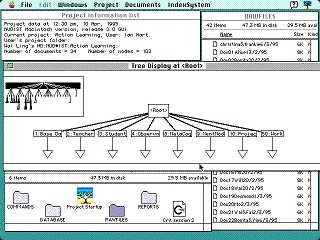|
 Home Home
 Overview Overview
 Powerpoint Powerpoint
 Guidelines Guidelines
 Research Research

|
Overview of QSR NUD*IST Software
NUD*IST or Non numerical Unstructured Data Indexing Searching and Theorizing software, is a robust and reliable program, appropriate exclusively for qualitative research analysis. This software is a good choice for simple analysis, such as text transcripts from focus group summaries or open-ended survey data to more complex theory construction and analysis. It is designed to automate much of the tedious work associated with qualitative data analysis, by auto coding signified text data, importing table data and using command files to regulate analysis processes.
A QSR NUD*IST project contains data documents, which can be on-line text documents, or off-line documents of any sort. It handles documents through a document management, search (including text search) and display system. It also contains a comprehensive Index System for holding categories of concepts, facts and ideas; and for coding the project documents using those categories, defining and annotating those codes, organising those codes taxonomically, and displaying their data. You can index and analyze any number and type of "document" at all: text files, newspaper clippings, books, photographs, maps, music, videotapes.
 QSR NUD*IST allows you to construct and modify a tree-structured "Index System" for a project. It is a repository for indexing codes into your documents, for the facts and categories and concepts you want to use in organising your data, and for commentary. Being tree-structured, the Index System acts as a powerful but simple taxonomic organiser of your ideas and your data indexing. There is no limit to the size or capacity of a project's Index System data (except those memory limits imposed by your computer). The index trees can be rearranged easily and flexibly as your ideas and understanding of your research project grow and change. QSR NUD*IST allows you to construct and modify a tree-structured "Index System" for a project. It is a repository for indexing codes into your documents, for the facts and categories and concepts you want to use in organising your data, and for commentary. Being tree-structured, the Index System acts as a powerful but simple taxonomic organiser of your ideas and your data indexing. There is no limit to the size or capacity of a project's Index System data (except those memory limits imposed by your computer). The index trees can be rearranged easily and flexibly as your ideas and understanding of your research project grow and change.
Documents are imported singly or in batches, in plain text with automatic formatting to the chosen unit of text. Coding on-screen, with new immediate access to the code system, the researcher can monitor and manage the emergence of ideas. Coded material is displayed for reflection, revision of coding and coding-on to new categories. With searches of coding or text accessed by new, visual displays, the researcher can test hypotheses, locate patterns or pursue a line of enquiry to a confident conclusion.
|